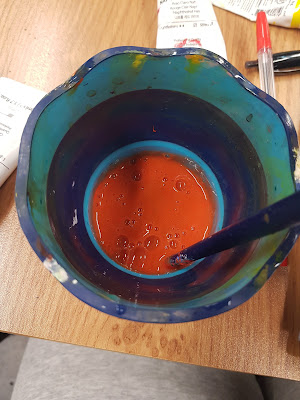Material Research: Gesso, Acrylics, Sand and Fluid Art
As seen in the Abstraction Workshop, I had bought some materials to create a textured canvas board ton put my artwork on. I bought six (two packs of three) 10” by 12” canvas boards to prepare the surface, and bought play sand and gesso to do the priming. As the sand I have got was coloured blue, the primed surface was slightly blue however it would not matter as I would paint over it with acrylics.
Materials and primed surfaces
Before I went on to create my final illustrations on these surfaces I experimented more with abstraction techniques, specifically the fluid art skills. While doing the abstraction technique with homage, I realised it may not be as suitable as this technique, especially when keeping note of the works of Penny Siopis. As the materials (primers) tend to be expensive, which may be critical since I would be using it a lot, I have found alternative ways to mimic this style by using soap. Although dishwashing fluids are more common in this technique, I found that the effects can be mimicked with other types of soap as well.
I poured these different solutions onto my sketchbook and saw how they interacted with each other. I made sure to keep note of the proportions of the solutions, making comments on how they interacted as well. Above is the photo taken before it was dried as due to the liquid nature of the solution, and the sketchbook pages being of common paper, it absorbed most of the solution and the textures and colours became less dominant. In this experimentation, I found that thicker mixes interacted better when being poured on top of thinner mixes and while blowing also created interesting textures, slowly moving the sketchbook can create unique marks as well. This will be important in creating my final works.









Good detailed explanation and analysis of the materials and process. the uniqueness of the process will create surfaces that would be difficult to achieve through a digital process, it's important that you have tried this technique as it has value to your outcomes.
ReplyDelete